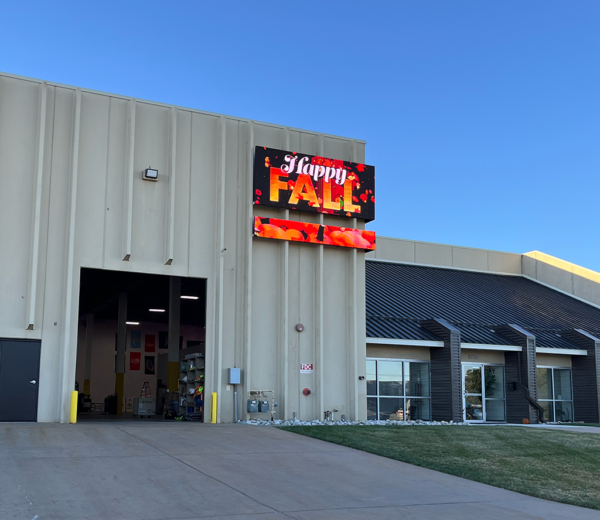Upgrading to LED signage at race tracks is more than a technological enhancement—it’s a strategic investment that can revolutionize fan experiences, streamline operations, and unlock new revenue streams. With careful planning, thoughtful design, and expert implementation, LED signage can transform race track environments, ensuring high visibility, interactivity, and long-term success.
This guide outlines the key steps to plan and implement LED signage upgrades, from initial assessments to ongoing maintenance, helping race tracks maximize their return on investment and deliver a world-class experience for fans and sponsors alike.

Step 1: Initial Planning and Assessment
Upgrading to LED displays for race tracks begins with a comprehensive assessment to align the project with your goals and ensure a smooth transition.
1. Define Objectives
Start by identifying your goals for the upgrade. Are you looking to:
- Improve fan engagement with dynamic and interactive displays?
- Increase operational efficiency with real-time updates and digital control?
- Attract additional sponsorships with vibrant, high-resolution advertising opportunities?
Clear objectives will guide decisions throughout the project.
2. Evaluate Existing Infrastructure
Assess your current signage setup to determine its compatibility with new LED technology. Key factors to consider include:
- Structural Integrity: Can existing structures support LED displays?
- Power Supply: Does your site meet the electrical requirements for high-brightness screens?
- Viewing Distance: Will the new signage be visible to all spectators, regardless of their location?
3. Budgeting
Create a detailed budget that includes:
- Design and equipment costs
- Installation and structural modifications
- Long-term maintenance expenses
By preparing a realistic budget, you’ll avoid surprises and ensure all aspects of the upgrade are accounted for.
Step 2: Design and Specification
1. Choose the Right LED Technology
Select LED signage that meets your venue’s specific needs. For race tracks, prioritize:
- High-resolution LED video displays for crisp visuals
- Weather-resistant outdoor LED signs for durability in various conditions
- Energy-efficient LED displays to lower operational costs
2. Design Layout
Collaborate with professional designers to create a layout that maximizes visibility and enhances fan engagement. Consider:
- Placement and orientation to ensure optimal viewing
- Integration with existing signage and architectural elements
- Appropriate screen sizes for both close-up and distant viewing
3. Content Strategy
Plan how you will use the LED signage to engage audiences effectively:
- Real-time race updates: Display live stats, lap times, and standings.
- Dynamic advertising: Showcase sponsor logos and video ads.
- Fan messages and event schedules: Keep audiences informed and entertained.
A well-thought-out content strategy ensures your displays remain relevant and captivating.
Step 3: Procurement and Installation
1. Select a Reliable Vendor
Partner with a trusted vendor experienced in providing LED signage solutions for race tracks. Evaluate their portfolio, client reviews, and customer support capabilities.
2. Installation Planning
Plan the installation process in detail:
- Schedule installations during off-peak periods to minimize disruptions.
- Prepare the site, ensuring it meets the structural and electrical requirements for the displays.
3. Testing and Calibration
Before going live, conduct rigorous testing to ensure:
- Visibility: Check clarity and brightness from all angles and distances.
- Accuracy: Verify content is displayed correctly and seamlessly integrated with control systems.
4. Ongoing Monitoring
Post-installation, monitor the signage to evaluate its performance and collect feedback from spectators and staff. Make adjustments as needed to optimize the experience.
Step 4: Maintenance for Long-Term Performance
To ensure the longevity and performance of your LED signage:
- Schedule regular inspections to identify and address potential issues.
- Perform routine cleaning to maintain brightness and clarity.
- Update software to stay compatible with evolving content requirements.
Proper maintenance safeguards your investment, keeping your displays impactful for years to come.

Why Upgrade to LED Signage for Race Tracks?
Upgrading to LED signage isn’t just about improving aesthetics—it’s about enhancing the overall race track experience. Key benefits include:
- High visibility: LED signs deliver vibrant, high-resolution visuals that stand out in any lighting condition.
- Increased sponsorship opportunities: Dynamic displays attract premium advertisers and generate new revenue streams.
- Engaging fan experience: From live updates to interactive features, LED signage keeps fans informed, entertained, and engaged.
- Operational efficiency: Real-time content updates reduce the need for manual interventions and ensure seamless communication.
By investing in cutting-edge LED technology, race tracks can elevate their events, attract larger audiences, and position themselves as leaders in innovation.



